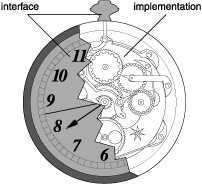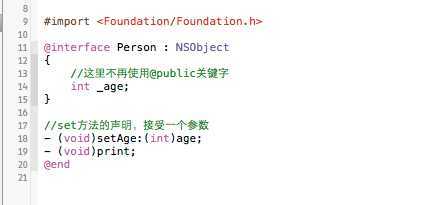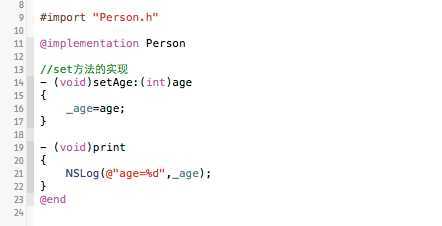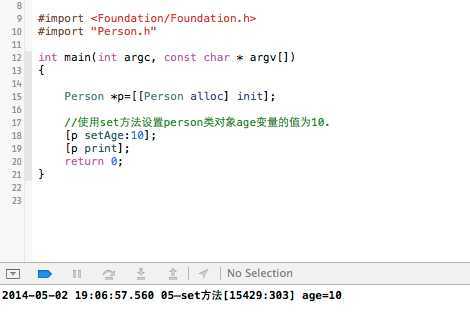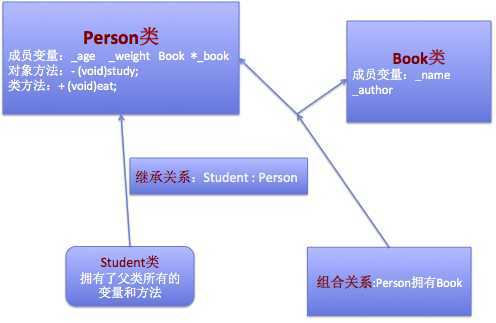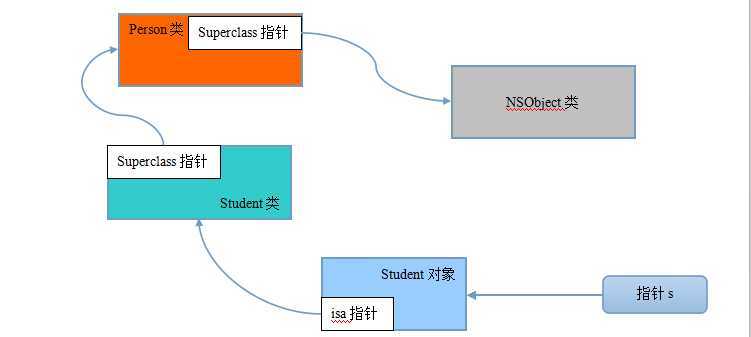封装主要体现在:实例变量、对象方法、类方法的封装
在开发过程中,考虑到安全性要求,我们一般不在成员变量名前面使用@public、@protected等关键字修饰
,而是使用Set方法来为对象提供成员变量的值。在set方法的内部也可以对一些不合理的赋值进行筛选滤。
Set方法的作用:为外界提供一个设置成员变量值的方法
命名规范
(1)方法名必须以set开头
(2)set后面跟上成员变量的名称,首字母大写
(4)一定要接收一个参数,而且参数类型需要和成员变量的类型一致
(5)形参名不能跟成员变量名一样(苹果官方推荐成员变量名前加_以示区分)
Set方法的好处:
(1)不让数据暴露在外,保证了数据的安全性
(2)对设置的数据进行过滤
Set方法使用示例:
Set方法的声明:
Set方法的实现:
测试程序:
- get方法
- Get方法的作用:为调用者返回对象内部的成员变量
- 命名规范:
- (1)一定有返回值,返回值的类型和成员变量的类型一致
- (2)方法名和成员变量名一样
- (3)不需要接收任何参数
- Get方法使用示例:
- Get方法的声明:
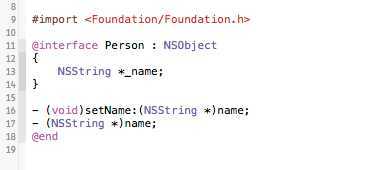
- Get方法实现

- 测试程序
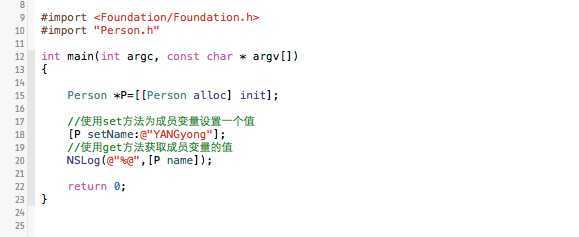
注意1:在实际的开发中,不一定set和get方法都会提供,如果内部的成员变量比如学生的学号这样的数据只允许外界读取,但是不允许修改的情况,则通常只提供get方法而不提供set方法。
注意2:成员变量名的命名以下划线开头,get方法名不需要带下划线,使用下划线开头有两个好处:(1)与get方法的方法名区分开来;(2)可以跟一些其他的局部变量区分开来,下划线开头的变量,通常都是类的成员变量。
继承
- 基本概念
继承的好处:
(1)抽取出了重复的代码
(2)建立了类和类之间的联系
继承的缺点:
耦合性太强
2. 代码:
/**********书************/
@interface Book : NSObject
{
int _name;
int _author; //作者
}
- (void)setName:(int)name;
- (int)name;
@end
@implementation Book
- (void)setName:(int)name
{
_name = name;
}
- (int)name
{
return _name;
}
@end
/**********人************/
@interface Person : NSObject
{
int _age;
double _weight;
Book *book; //组合关系
}
- (void)study;
+ (void)eat;
@end
//方法实现部分省略了
/**********学生************/
@interface Student : Person //Student 继承了Person
- (void)liuDog; //遛狗
@end
3.继承和组合
继承的适用场合:
(1)当两个类拥有相同的属性和方法时,就可以将相同的属性和方法抽取到一个父类中。
(2)当A类完全拥有B类中的部分属性和方法时,可以考虑让B类继承A类(考虑),在这种情况下,也可以考虑使用组合。
继承:###是xxx,如狗是动物,可以让狗继承动物类
组合:###拥有xxx,如学生有书,可以让书这个类作为学生类的属性
4.继承的使用注意
(1)编译器从上往下执行,所以在子类前面至少应该要有父类的声明;
(2)OC中不允许子类和父类拥有相同名称的成员变量名;
(3)OC中的子类可以拥有和父类相同名称的方法,在子类调用时,优先去自己的内部寻找,如果没有则一层一层的往上找;
提示:重写即子类重新实现了父类中的某个方法,覆盖了父类以前的实现。
示意图:一共有三个类,Person类继承了NSObject类,Student类继承了Person类。
创建一个Student *s=[[Student alloc] init];
此时会把Student类和这个类的父类加载进内存。
提示:每个类中都有一个super class指针,该指针指向自己的父类。对象中有一个isa指针,该指针指向调用该对象的类。
多态
多态对于面向对象思想来说,个人感觉是真的很重要,他对以后的编写代码的优雅方式也是起到很重要的作用,其实现在很多设计模式中大部分都是用到了多态的特性,其实多态说白了就是:定义类型和实际类型,一般是基于接口的形式实现的,不多说了,直接看例子吧:
打印机的例子
抽象的打印机类Printer
Printer.h
1. //
2. // Printer.h
3. // 07_DynamicDemo
4. //
5. // Created by jiangwei on 14-10-11.
6. // Copyright (c) 2014年 jiangwei. All rights reserved.
7. //
8.
9. #import <Foundation/Foundation.h>
10.
11. @interface Printer : NSObject
12.
13. - (void) print;
14.
15. @end
就是一个简单的方法print
Printer.m
1. //
2. // Printer.m
3. // 07_DynamicDemo
4. //
5. // Created by jiangwei on 14-10-11.
6. // Copyright (c) 2014年 jiangwei. All rights reserved.
7. //
8.
9. #import "Printer.h"
10.
11. @implementation Printer
12.
13. - (void)print{
14. NSLog(@"打印机打印纸张");
15. }
16.
17. @end
实现也是很简单的
下面来看一下具体的子类
ColorPrinter.h
1. //
2. // ColorPrinter.h
3. // 07_DynamicDemo
4. //
5. // Created by jiangwei on 14-10-11.
6. // Copyright (c) 2014年 jiangwei. All rights reserved.
7. //
8.
9. #import "Printer.h"
10.
11. //修改父类的打印行为
12. @interface ColorPrinter : Printer
13. - (void)print;
14. @end
ColorPrinter.m
1. //
2. // ColorPrinter.m
3. // 07_DynamicDemo
4. //
5. // Created by jiangwei on 14-10-11.
6. // Copyright (c) 2014年 jiangwei. All rights reserved.
7. //
8.
9. #import "ColorPrinter.h"
10.
11. @implementation ColorPrinter
12.
13. - (void)print{
14. NSLog(@"彩色打印机");
15. }
16.
17. @end
在看一下另外一个子类
BlackPrinter.h
1. //
2. // BlackPrinter.h
3. // 07_DynamicDemo
4. //
5. // Created by jiangwei on 14-10-11.
6. // Copyright (c) 2014年 jiangwei. All rights reserved.
7. //
8.
9. #import "Printer.h"
10.
11. @interface BlackPrinter : Printer
12.
13. - (void)print;
14.
15. @end
BlackPrinter.m
1. //
2. // BlackPrinter.m
3. // 07_DynamicDemo
4. //
5. // Created by jiangwei on 14-10-11.
6. // Copyright (c) 2014年 jiangwei. All rights reserved.
7. //
8.
9. #import "BlackPrinter.h"
10.
11. @implementation BlackPrinter
12.
13. - (void)print{
14. NSLog(@"黑白打印机");
15. }
16.
17. @end
这里我们在定义一个Person类,用来操作具体的打印机
Person.h
1. //
2. // Person.h
3. // 07_DynamicDemo
4. //
5. // Created by jiangwei on 14-10-11.
6. // Copyright (c) 2014年 jiangwei. All rights reserved.
7. //
8.
9. #import <Foundation/Foundation.h>
10.
11. #import "ColorPrinter.h"
12. #import "BlackPrinter.h"
13.
14. //扩展性不高,当我们需要添加一个新的打印机的时候还要定义对应的一个方法
15. //所以这时候就可以使用多态技术了
16.
17. @interface Person : NSObject{
18. NSString *_name;
19. }
20.
21. //- (void) printWithColor:(ColorPrinter *)colorPrint;
22.
23. //- (void) printWithBlack:(BlackPrinter *)blackPrint;
24.
25. - (void) doPrint:(Printer *)printer;
26.
27. @end
Person.m
1. //
2. // Person.m
3. // 07_DynamicDemo
4. //
5. // Created by jiangwei on 14-10-11.
6. // Copyright (c) 2014年 jiangwei. All rights reserved.
7. //
8.
9. #import "Person.h"
10.
11. @implementation Person
12.
13. /*
14. - (void) printWithColor:(ColorPrinter *)colorPrint{
15. [colorPrint print];
16. }
17.
18. - (void) printWithBlack:(BlackPrinter *)blackPrint{
19. [blackPrint print];
20. }
21. */
22.
23. - (void) doPrint:(Printer *)printer{
24. [printer print];
25. }
26.
27. @end
再来看一下测试代码:
main.m
1. //
2. // main.m
3. // 07_DynamicDemo
4. //
5. // Created by jiangwei on 14-10-11.
6. // Copyright (c) 2014年 jiangwei. All rights reserved.
7. //
8.
9. #import <Foundation/Foundation.h>
10.
11. #import "Person.h"
12. #import "BlackPrinter.h"
13. #import "ColorPrinter.h"
14.
15. int main(int argc, const charchar * argv[]) {
16. @autoreleasepool {
17.
18. Person *person =[[Person alloc] init];
19.
20. ColorPrinter *colorPrint = [[ColorPrinter alloc] init];
21. BlackPrinter *blackPrint = [[BlackPrinter alloc] init];
22.
23. //多态的定义
24. /*
25. Printer *p1 = [[ColorPrinter alloc] init];
26. Printer *p2 = [[BlackPrinter alloc] init];
27.
28. [person doPrint:p1];
29. [person doPrint:p2];
30. */
31.
32. //通过控制台输入的命令来控制使用哪个打印机
33. int cmd;
34. do{
35. scanf("%d",&cmd);
36. if(cmd == 1){
37. [person doPrint:colorPrint];
38. }else if(cmd == 2){
39. [person doPrint:blackPrint];
40. }
41. }while (1);
42.
43. }
44. return 0;
45. }
下面就来详细讲解一下多态的好处
上面的例子是一个彩色打印机和黑白打印机这两种打印机,然后Person类中有一个操作打印的方法,当然这个方法是需要打印机对象的,如果不用多态机制实现的话(Person.h中注释的代码部分),就是给两种打印机单独定义个操作的方法,然后在Person.m(代码中注释的部分)中用具体的打印机对象进行操作,在main.m文件中,我们看到,当Person需要使用哪个打印机的时候,就去调用指定的方法:
1. [person printWithBlack:blackPrint];//调用黑白打印机
2. [person printWithColor:colorPrint];//调用彩色打印机
这种设计就不好了,为什么呢?假如现在又有一种打印机,那么我们还需要在Person.h中定义一种操作这种打印机的方法,那么后续如果在添加新的打印机呢?还在添加方法吗?那么Person.h文件就会变得很臃肿。所以这时候多态就体现到好处了,使用父类类型,在Person.h中定义一个方法就可以了:
1. - (void) doPrint:(Printer *)printer;
这里看到了,这个方法的参数类型就是父类的类型,这就是多态,定义类型为父类类型,实际类型为子类类型
1. - (void) doPrint:(Printer *)printer{
2. [printer print];
3. }
这里调用print方法,就是传递进来的实际类型的print方法。
1. Printer *p1 = [[ColorPrinter alloc] init];
2. Printer *p2 = [[BlackPrinter alloc] init];
3.
4. [person doPrint:p1];
5. [person doPrint:p2];
这里的p1,p2表面上的类型是Printer,但是实际类型是子类类型,所以会调用他们自己对应的print方法。
从上面的例子中我们就可以看到多态的特性很是重要,当然也是三大特性中比较难理解的,但是在coding的过程中,用多了就自然理解了,没必要去刻意的理解。
总结
这篇文章主要介绍了类的三大特性:封装、继承、多态,这三个特性也是后面学习面向对象的重要基础。
